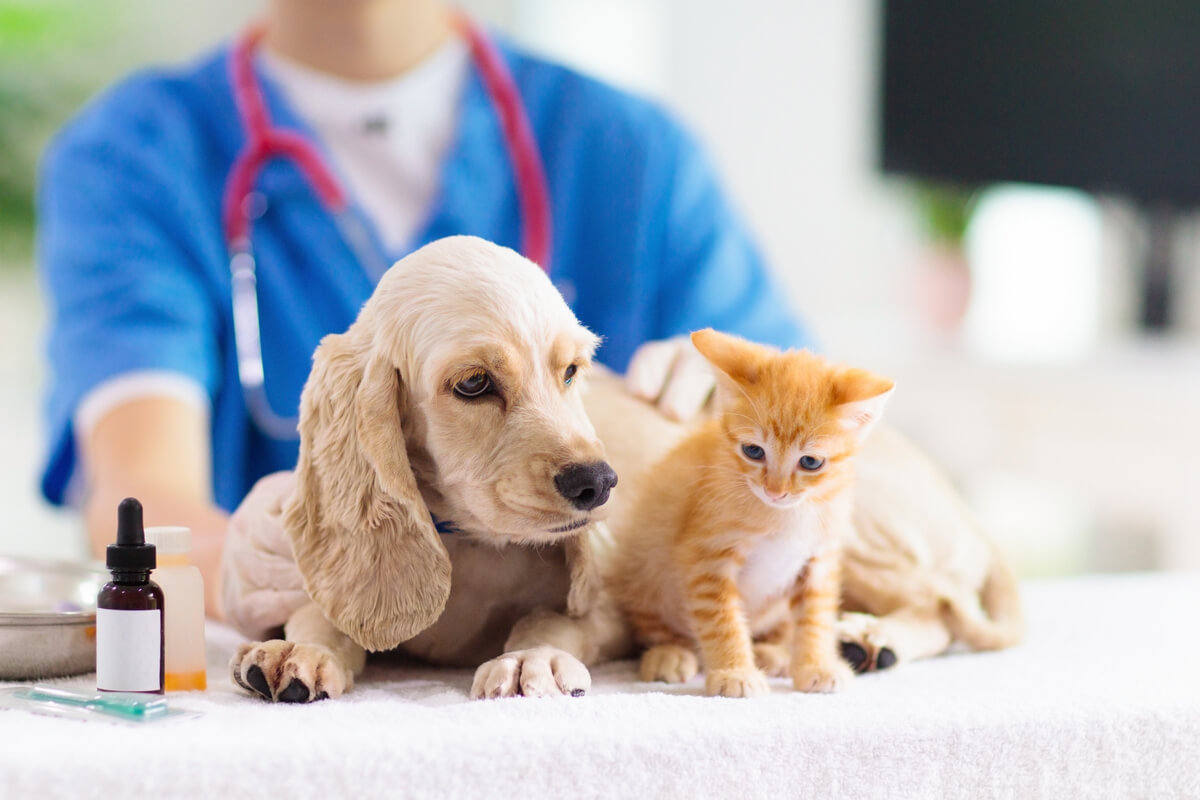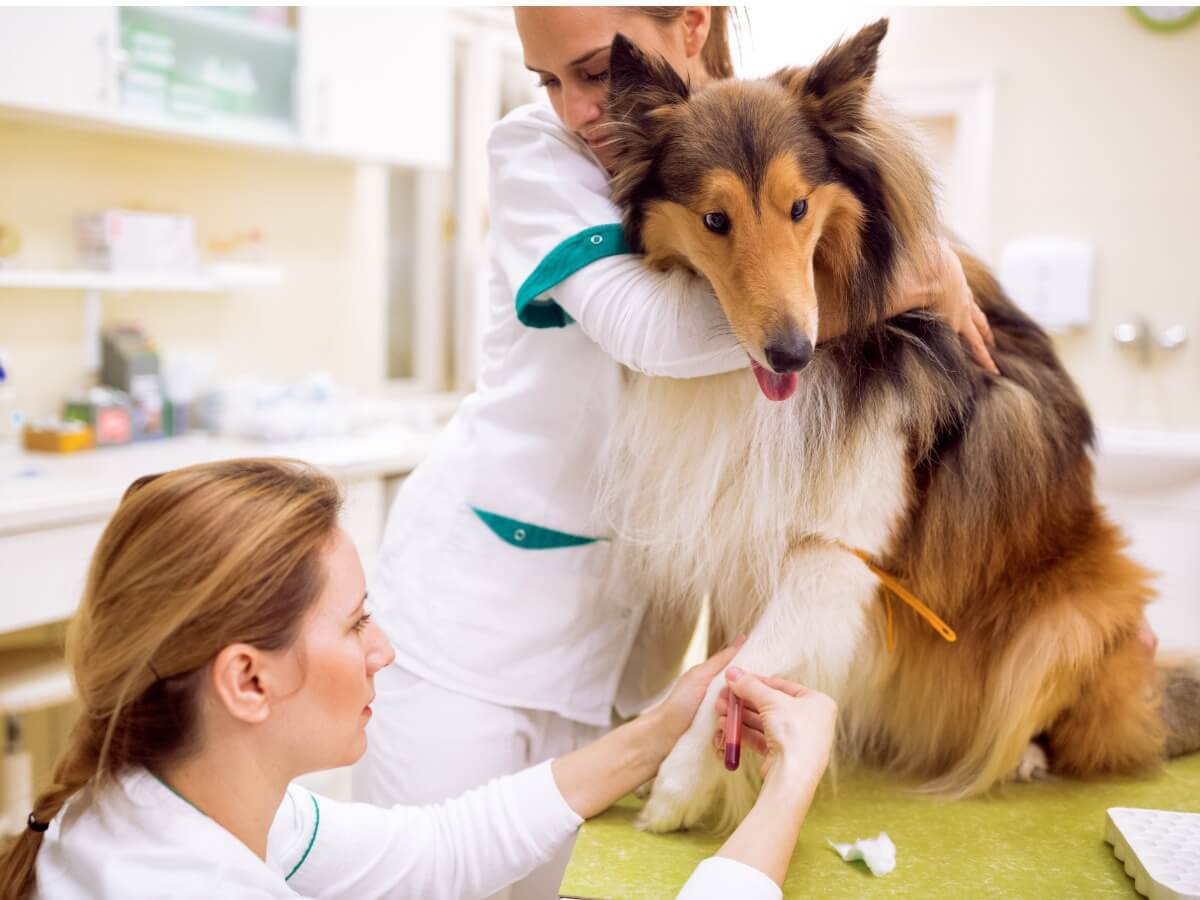Catosal for Dogs and Cats: Dosage and Side Effects


Written and verified by the biologist Francisco Morata Carramolino
The world of medicines for animals is increasingly comprehensive, advanced, and complex. Furthermore, while many of the drugs for humans are familiar to us, those designed for pets are largely unknown to the general public. All this can cause confusion about the medicines that the veterinary professional has indicated. In order to remedy this, in this space we’re going to talk about catosal, a drug commonly used for many animal species. If you want to know more about its features, keep reading!
What is catosal?
Catosal is a medication in injectable form. It’s liquid, pink, and semi-transparent. It can be used for various animal species such as dogs, cats, horses and cattle. Like many others, this drug is made up of active substances and excipients.
The active substances in catosal are two: butaphosphan and cyanocobalamin, a form of vitamin B12. These are the compounds that give the drug its biological properties, beyond the excipients that give the drug its physical qualities, among other things.
On the one hand, butaphosphan acts as a source of phosphorus that can be used by the animal’s metabolism. Phosphorus is an essential element for the functioning of living beings, as it intervenes in innumerable biochemical reactions.
Among them, it should be noted that this element participates in the phosphorylation and dephosphorylation processes, necessary in many metabolic pathways at the cellular level. It’s also an integral part of the synthesis of glucose, an important source of energy.
On the other hand, B12 is a water-soluble vitamin that cannot be synthesized by mammalian metabolism. Therefore, it must be incorporated in other ways. In normal situations, this micronutrient is obtained through diet.
Vitamin B12 is involved in a multitude of processes necessary for the body. It’s essential for the proper functioning of the liver, muscle tissue, skin, brain and pancreas, among many other roles.
Apart from the active principles, catosal is formed by n-butanol and sodium hydroxide, which act as excipients. These compounds don’t have a biological function by themselves, but they serve as a chemical vehicle and facilitate the action of the active substances.

Uses of catosal
In dogs and cats, this medicine is used as a treatment for vitamin B12 or phosphorus deficiencies and related disorders. These deficiencies produce a series of symptoms in these animals, among which are the following:
- Lack of energy
- Loss of appetite
- Weight loss
- Diarrhea or vomiting
- Muscle weakness and pain
- Confusion
Given these symptoms, it’s best to see a veterinary professional as soon as possible. If the aforementioned deficits are responsible for these conditions, the professional may recommend this drug.
Similarly, catosal can be recommended in cases of metabolic disorders and chronic or acute diseases. It can also be used for seizures, paralysis, anemia or cases of malnutrition, but it should always be prescribed in advance by a professional.
Dosage for cats and dogs
Taking into account their physiological differences, as well as their weight and size, catosal requires specific doses for each species, breed and specimen. The range of action isn’t the same for a cat as it is for a dog, as their physiology is different and the total mass of each individual depends on many parameters.
For dogs and cats, the recommended dose is between 0.1 and 0.15 milligrams per kilo of animal weight. In the case of cyanocobalamin, it’s 0.005 – 0.0075 milligrams per kilogram.
These doses are administered by injection, either intravenously, subcutaneously, or intramuscularly. The dose can be repeated once a day for 3 days in a row.
On the other hand, it should be noted that the drug can only be prescribed and administered by a veterinarian. This professional has the necessary knowledge to decide the appropriate doses and treatments for each specific case. Never self-medicate your pet!
Side effects and contraindications
Catosal has no reported adverse side effects. Even so, there are certain recommendations on its use that should be taken into account in the veterinary clinic.
This drug should never be used if hypersensitivity to any of the active substances or excipients has been detected in the animal patient. There are hardly any studies on the compatibility of catosal with other drugs, so it should not be used if the animal is already receiving another treatment.
This compound has not been found to produce relevant systemic effects in cases of overdose of up to 5 times the recommended dose. Even so, a series of transient and local reactions have been observed when it’s administered subcutaneously – compared to intramuscular and intravenous.
Personnel administering the drug must also take certain precautions. This compound can cause skin and eye irritations, so it’s important to avoid contact with the eyes and skin. If accidental exposure occurs, the affected area must be washed with plenty of water.
There’s a possibility, albeit remote, that any drug will produce an unexpected adverse reaction, especially in cases of allergies. If any side effect is observed in the pet, it’s best to quickly contact a veterinarian.

As we have observed, catosal is a simple and safe medicine that can improve the health of domestic animals with nutritional deficiencies. Even so, it’s crucial to note that this article is merely informative. Before making any decision about a pet’s health, we recommend consulting a trusted veterinarian.
The world of medicines for animals is increasingly comprehensive, advanced, and complex. Furthermore, while many of the drugs for humans are familiar to us, those designed for pets are largely unknown to the general public. All this can cause confusion about the medicines that the veterinary professional has indicated. In order to remedy this, in this space we’re going to talk about catosal, a drug commonly used for many animal species. If you want to know more about its features, keep reading!
What is catosal?
Catosal is a medication in injectable form. It’s liquid, pink, and semi-transparent. It can be used for various animal species such as dogs, cats, horses and cattle. Like many others, this drug is made up of active substances and excipients.
The active substances in catosal are two: butaphosphan and cyanocobalamin, a form of vitamin B12. These are the compounds that give the drug its biological properties, beyond the excipients that give the drug its physical qualities, among other things.
On the one hand, butaphosphan acts as a source of phosphorus that can be used by the animal’s metabolism. Phosphorus is an essential element for the functioning of living beings, as it intervenes in innumerable biochemical reactions.
Among them, it should be noted that this element participates in the phosphorylation and dephosphorylation processes, necessary in many metabolic pathways at the cellular level. It’s also an integral part of the synthesis of glucose, an important source of energy.
On the other hand, B12 is a water-soluble vitamin that cannot be synthesized by mammalian metabolism. Therefore, it must be incorporated in other ways. In normal situations, this micronutrient is obtained through diet.
Vitamin B12 is involved in a multitude of processes necessary for the body. It’s essential for the proper functioning of the liver, muscle tissue, skin, brain and pancreas, among many other roles.
Apart from the active principles, catosal is formed by n-butanol and sodium hydroxide, which act as excipients. These compounds don’t have a biological function by themselves, but they serve as a chemical vehicle and facilitate the action of the active substances.

Uses of catosal
In dogs and cats, this medicine is used as a treatment for vitamin B12 or phosphorus deficiencies and related disorders. These deficiencies produce a series of symptoms in these animals, among which are the following:
- Lack of energy
- Loss of appetite
- Weight loss
- Diarrhea or vomiting
- Muscle weakness and pain
- Confusion
Given these symptoms, it’s best to see a veterinary professional as soon as possible. If the aforementioned deficits are responsible for these conditions, the professional may recommend this drug.
Similarly, catosal can be recommended in cases of metabolic disorders and chronic or acute diseases. It can also be used for seizures, paralysis, anemia or cases of malnutrition, but it should always be prescribed in advance by a professional.
Dosage for cats and dogs
Taking into account their physiological differences, as well as their weight and size, catosal requires specific doses for each species, breed and specimen. The range of action isn’t the same for a cat as it is for a dog, as their physiology is different and the total mass of each individual depends on many parameters.
For dogs and cats, the recommended dose is between 0.1 and 0.15 milligrams per kilo of animal weight. In the case of cyanocobalamin, it’s 0.005 – 0.0075 milligrams per kilogram.
These doses are administered by injection, either intravenously, subcutaneously, or intramuscularly. The dose can be repeated once a day for 3 days in a row.
On the other hand, it should be noted that the drug can only be prescribed and administered by a veterinarian. This professional has the necessary knowledge to decide the appropriate doses and treatments for each specific case. Never self-medicate your pet!
Side effects and contraindications
Catosal has no reported adverse side effects. Even so, there are certain recommendations on its use that should be taken into account in the veterinary clinic.
This drug should never be used if hypersensitivity to any of the active substances or excipients has been detected in the animal patient. There are hardly any studies on the compatibility of catosal with other drugs, so it should not be used if the animal is already receiving another treatment.
This compound has not been found to produce relevant systemic effects in cases of overdose of up to 5 times the recommended dose. Even so, a series of transient and local reactions have been observed when it’s administered subcutaneously – compared to intramuscular and intravenous.
Personnel administering the drug must also take certain precautions. This compound can cause skin and eye irritations, so it’s important to avoid contact with the eyes and skin. If accidental exposure occurs, the affected area must be washed with plenty of water.
There’s a possibility, albeit remote, that any drug will produce an unexpected adverse reaction, especially in cases of allergies. If any side effect is observed in the pet, it’s best to quickly contact a veterinarian.

As we have observed, catosal is a simple and safe medicine that can improve the health of domestic animals with nutritional deficiencies. Even so, it’s crucial to note that this article is merely informative. Before making any decision about a pet’s health, we recommend consulting a trusted veterinarian.
All cited sources were thoroughly reviewed by our team to ensure their quality, reliability, currency, and validity. The bibliography of this article was considered reliable and of academic or scientific accuracy.
- https://veterinary-practice.com/article/the-importance-of-the-b-vitamins
- https://www.sciencelearn.org.nz/resources/961-the-phosphorus-cycle
- https://www.animalbiome.com/blog/b12-deficiency-in-dogs-and-the-role-of-the-gut
- https://www.msdvetmanual.com/metabolic-disorders/disorders-of-phosphorus-metabolism/hypophosphatemia-in-animals
- https://www.animalbiome.com/blog/vitamin-b12-deficiency-in-cats-the-role-of-the-gut
- https://farmahigiene.es/producto/catosal/
- https://vetconecta.elanco.com/our-products/catosal/catosal#section-Catosal-Aplicaci%C3%B3n
- https://zoneforpets.com/2018/08/05/catosal-vitamin-b12-phosphorus-metabolism-stimulate-supplement/
- Catosal – Ficha técnica. Departamento de Medicamentos Veterinarios, Agencia Española de Medicamentos y Productos Sanitarios, Ministerio de Sanidad
This text is provided for informational purposes only and does not replace consultation with a professional. If in doubt, consult your specialist.








